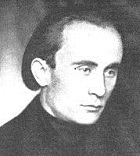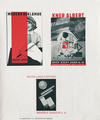Kassák Lajos
1887 - 1967

Kassák, Lajos
A central figure of the Hungarian avant-garde movement, Lajos Kassák (March 21, 1887 – July 22, 1967) was a writer, painter, designer, and labour organiser. Although he was one of the founders of the modernist poster style in Hungary in the 1920s, only a few of his posters have survived. Kassák did not attend university, he was completely self-taught. His work and theoretical writings about poster art and advertising had a huge impact on Hungarian commercial graphic design.
Kassák’s art reflects his leftist political views. As a young worker and believer, he was constantély fighting for the rights of the workers both in his writings and his deeds. He organized several strikes which often caused him problems such as being fired from numerous positions. According to his memoirs, Egy ember élete (A Man's Life), he travelled by foot to Paris in 1909, where he stayed for one year.
In 1915, once again in Hungary, he published his first avant-garde magazine, Tett (The Deed), which was soon suppressed by the authorities due to its antimilitarism. Between 1916 and 1925, Kassák published Ma (Today), the most important review of modern art in Hungary. During the Hungarian Soviet Republic of March-August 1919, Kassák became a member of the Writers Directorate. After the regime’s fall, he emigrated to Vienna where he continued to publish Ma.
After returning to Hungary in 1925, he issued three new magazines: 365, Dokumentum (Document) and Munka (Work). In the new socialist regime established after World War II, Kassák began to edit Kortárs (Contemporary), a journal affiliated with the Social-Democratic Party.
As the politics of the new regime started to become stricter and forced the country’s political parties to melt into one communist party, Kassák found himself embroiled in political conflicts. Eventually, he was expelled from the communist party and his works were banned. While the situation began to ease after 1956, he was not allowed to leave the country, not even when his works got exhibited abroad.
Kassák played a central role in the Hungarian avant-garde movement as an artist and theoretician. His movement, “aktivizmus” (activism), was a typical avant-garde art group, defined by utopian leftist ideologies, mainly the wish for a new, democratic and egalitarian society. The “picture-architecture” art, the name given by Kassák first to the works of Sándor Bortnyik and later to his own paintings, symbolised a man-made perfect order that should mirror the ideal social order.
Kassák reported about most of the important foreign artistic trends in MA, relying on his wide international contacts (for example, his reporter from Berlin was László Moholy-Nagy). Kassák did not only play an important role in the graphic design of his age but also in literature, as he wrote novels and poems.
In the history of Hungarian poster art, Kassák is considered to be one of the founders of modernism, and one of the most prominent theoretical writers. We know only a few of his posters and original designs. He created the first flat-like constructivist composition for a poster, and in 1924 he sent this design to Magyar Hírlap (Hungarian News) from Vienna. On some of his designs, he combined geometric, colored forms with photographs or montages, which formed a new artistic unity.
In 1916, Kassák published a famous article, “The poster and the new painting,” which became a fundamental work on avant-garde painting and for modern poster design. Kassák compared the freshness, suggestive power and compact visual language of the poster to the modern painting. According to Kassák, the poster is the most radical form of art, since it constantly needs to reinvent itself. In 1926, Kassák summed up his thoughts in his book A tisztaság könyve (Book of clearness). In 1928, he composed the basic characteristics of the modernist poster in an article. .







